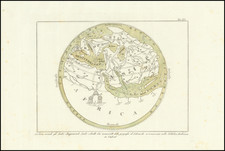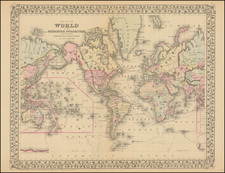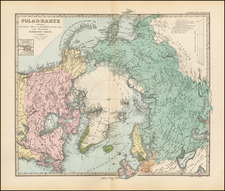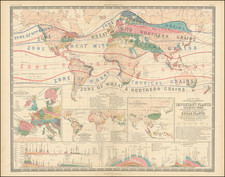An Early Italian World Map of the Highest Importance
Fine example of first state of Antonio Salamanca's double cordiform map of the World, published in about 1550 in Rome.
This extraordinary world map was first published in 1550 in Rome by Antonio Salamanca. Antonio Salamanca (fl. 1550-62) was of Spanish origin, and his maps were known for their especially fine design and engraving.
Salamanca's double cordiform map of the World is the earliest obtainable map based upon Gerard Mercator's landmark world map of 1538. Consider perhaps the single most important mapmaker of the 16th Century, Gerard Mercator (1512-1594) was only 26 years old when he published his first world map. Preceded only by his map of Palestine, the work is of tremendous importance and rarity, with only two known examples surviving (New York Public Library and American Geographical Society). Mercator's map was the first to apply the name "America" to both North and South America. It is also one of the first maps to show North America separated from Asia. Many other cartographic advances are included, reflecting Mercator's meticulous compilation of the best available information. Most notably, Mercator seems to have had access to one of Diego Ribero's manuscript maps of the World or Asia, as his treatment of the Malay Peninsula and Pegu (Cambodia, Laos and Vietnam) was remarkable for a Northern European printed map. The American Geographical Society example of the map can be seen here https://collections.lib.uwm.edu/digital/collection/agdm/id/854/
As Mercator's original is unobtainable to collectors, Antonio Salamanca's map is the earliest obtainable example of Mercator's work While we date the map to circa 1550, the British Library has dated there example 1543(?) and the National Maritime Museum lists a date of 1545. Like the Mercator, Salamanca's world map rendering bisects the world on the equator, with the southern hemisphere featuring a mysterious continent centered on the South Pole, centuries before the discovery of Antarctica. Following Mercator, Salamanca showed the Americas as being two continents, labeled north and south, and being entirely separate from Asia. A large ice-mass is shown covering the world's Arctic regions. Salamanca's rendering is visually distinguishable from Mercator's map by his use of stipple engraving for the seas, an engraving style which was revolutionary for the time period, but would ultimately become a standard means for depicting the ocean.
The map notes that North America was "conquered" by Spain in 1530. The mouth of the Hudson River is shown, based upon the discoveries of Verrazzano in 1524. Florida is named, although the voyages of Jacques Cartier do not appear. The Northwest Passage is identified as Freti Arcticum.
In South America, the Rio de La Plata appears, although it is unnamed. Gigantum Regio (region of giants) is shown, an early reference to the giants of Patagonia. Peru is described as a highly civilized and rich country. The Straits of Magellan appear, an early credit to the Portugese explorer Ferdinand Magellan, with a massive South Polar continent shown, following Fine's map.
As noted by Rodney Shirley:
Gerard Mercator is accepted as one of the greatest cartographers of all time. . . . by 1538 when he was 26 he was already well know as a professional instrument maker and cartographer. . . the world map here described is only his second complete work. It is a beautiful fresh engraving; acheived by re-introduceing the more durable copperplate with finely scripted italic lettering instead of the coarser woodblock which had been preferred for the past twenty-five years.
Mercator's map . . . generally follows Oronce Fine's similar map of 1531 but with some novel and original features. For the first time the name 'America' is applied to North and South America, and both parts of the New World are unambiguously linked as one continent. However, unlike most of his predecessors, Mercator seperated North America from Asia -- thus initiating a controversy as to the precise link between the two continents that was not fully resolved for over 200 years. . .
Only two copies of Mercator's 1538 map are extant, in the possession of the New York Public Library and the American Geographical Society. No later examples are known but a new plate closely copying the original was made for sale by the Italian Antonio Salamanca in about 1550 and later published under the imprint of Antonio Lafreri [in 1564].
Beyond being a most elegant artistic concept, cordiform maps were considered to be imbued with great emblematic significance by contemporary humanists, in that they linked the human heart, the innate source of reason, with the grander theatre of the world of human action (Giorgio Mangani: 'Abraham Ortelius and the Hermetic Meaning of the Cordiform Projection', Imago Mundi, 50 (1998), pp. 59-83).
The Island of Seven Cities
The map identifies "Insulae 7 Civitatum" in the Atlantic Ocean off the North American Coastline. The term "Insule 7 civitatum," translating to "Islands of the Seven Cities," relates to a medieval Iberian legend. This legend tells of an archbishop and six bishops who, along with their followers, fled the Muslim invasion of Hispania during the 8th century. They journeyed westwards from Portugal, across the Atlantic Ocean, and landed one one or more islands where they established seven cities, one for each bishop.
The legend is first depicted on a 1424 Nautical Chart, and later maps, as Antilia. Notably, on these maps, the islands are labeled with specific place names, suggesting a degree of geographical knowledge or at least speculation that goes beyond mere myth. In his book, Phantom Islands of the Atlantic (1994), Donald S. Johnson dedicates a chapter to "Antillia: The Isle of Seven Cities," further elaborating on the legend and its impact on historical cartography. He explores the depiction of these cities on maps, supporting the notion that these details might not be purely imaginative but could indicate actual knowledge of or speculation about uncharted lands.
Fretum Arcticum
Between the Arctic and Baccalearu Regio in northerneasten Canada, the Fretu Arcticum appears on the map. In the middle of the 16th century, the concept of the "Fretum Arcticum," or the Arctic Strait, captured the imagination of explorers, traders, and cartographers alike. This mythical sea route, also known as the Northwest Passage, promised a shorter path from Europe to Asia. The belief in the existence of this passage, and the attempts to locate it, had a significant impact on the development of world exploration and map-making during this era.
The search for the Northwest Passage was pioneered by explorers like John Cabot, who, sponsored by the English king Henry VII, made voyages to North America in the late 15th century. Although Cabot himself never claimed to have found a Northwest Passage, his explorations opened the door to the possibility. His reports, along with those of the Italian explorer Giovanni da Verrazzano in 1524, who also suggested the existence of such a passage, shaped the European perception of North American geography and fueled further expeditions in search of the passage. One such explorer was Jacques Cartier who, during his voyages in the 1530s and 1540s, explored the Saint Lawrence River with hopes of finding a Northwest Passage.
In the 16th century, maps began to feature the Fretum Arcticum more prominently, albeit with various inaccuracies and a blend of fact and fantasy. One of the most famous of these is the 1569 world map by Gerardus Mercator, where he optimistically includes the Northwest Passage.
The concept of Fretum Arcticum also influenced the voyages of Sir Humphrey Gilbert and his half-brother Sir Walter Raleigh. These expeditions represented the culmination of a century of exploration and conjecture about the Arctic passage, solidifying the Northwest Passage as a dominant theme in the history of exploration and cartography.
Island of Sacrifices / Isla de Sacrificios
The map names the Insule Sacrificiorum (Island of Sacrifices). The name "Insula Sacrificiorum" traces back to the Spanish expedition under Juan de Grijalva in 1518. This expedition was the first to chart this section of the Gulf Coast, during which the crew encountered a previously unknown island that later came to be known as the Isla de Sacrificios.
A member of Grijalva's expedition, Bernal Díaz, provided an extensive account of the journey in his work Historia verdadera de la conquista de la Nueva España. Díaz’s narratives vividly illustrate their landing on the island and their encounters with the indigenous peoples. Their practices, notably human sacrifices, were deeply impactful to the expedition members, who named the island in reflection of this cultural interaction.
As the narratives of Díaz and other conquistadores spread across Europe, the Isla de Sacrificios gained notoriety in the European collective consciousness. Cartographers of the era, like Alonso de Santa Cruz and Sebastian Münster, incorporated the island in various forms into their maps. The "Insula Sacrificiorum" thus came to symbolize the unfamiliar and exotic cultures of the New World.
States of the Map and Rarity
The map is known in 3 states:
- Circa 1550: Salamanca name at bottom of lower cartouche (Ant. Sal. Exc. Romae)
- Circa 1564: Salamanca name re[placed by the name of Antonio Lafreri (Ant. Lafreri. Exc. Romae)
- Circa 1602: Imprint changed to Orlandi
All states of the map are extremely rare. The last example of the first state of the map which we could track was the example at Christies Paris, in 2006 (sold for approximately $122,000) and the present example, which sold at Christies New York in 1991 for $58,300.
Antonio Salamanca was a print seller and publisher based in Rome. While he was known by the surname Salamanca, his family name was actually Martinez; he hailed from Salamanca, Spain. His shop was in the Campo de’ Fiori and it served as a gathering place for those with antiquarian interests. Later in his career, he partnered with Antonio Lafreri, the era’ most prominent Italian map publisher. Salamanca’s stock was sold to Lafreri after the former’s death.












![(Second World War) Der Grossasiatisch-Amerikanische Raum [The Great Asiatic-American Space]](https://storage.googleapis.com/raremaps/img/small/88834.jpg)
![[Nova Zembla]](https://storage.googleapis.com/raremaps/img/small/75007.jpg)
